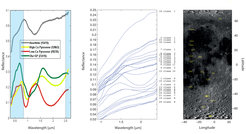The Surface of the Moon
Motivation
Studying the chemical composition of planetary body surfaces both in the inner and the outer solar system is of high relevance for an investigation of the conditions soon after their formation over a wide range of distances from the Sun.
Method and Challenges
Reflectance spectroscopy is an important tool to acquire information on the composition of the surface of the investigated objects. The solar light reflected from the investigated surfaces carries information on the mineralogy of the observed soils and rocks on those bodies. Reflectance spectroscopy in the wavelength range between about 400 and 3000 nm allows for an analysis of the most prominent minerals (see Figure below).

Principle of planetary reflectance spectroscopy: Solar light is reflected from the uppermost lunar surface layer and is measured by an instrument orbiting a planetary body. The light’s intensity is measured as a function of the wavelength and shows characteristic absorption features, which allow determining the composition of the observed surface area on the planet.
The necessary deconvolution process, however, which has to be applied to a reflectance spectrum to arrive at a modal mineralogical abundance estimate represents an extremely challenging task since the observed spectra are the result of complex processes which are commonly described by (partially physical and partially empirical) nonlinear models involving a variety of typically not well constrained parameters.
While in the near future it will remain impossible to confront conclusions about mineralogical composition won through complex deconvolution processes of reflectance spectra from outer solar system bodies with laboratory measurements obtained based on returned samples, the situation is different for the Moon. The lunar surface is not only important in a planetary or solar system wide context, but due to the availability of a large set of returned samples it provides a unique opportunity to develop, test and improve remote sensing methods for estimating the composition of planetary regoliths.
While there is no shortage of VIS-NIR spectra of in-situ observed lunar surfaces areas, only the very recent lunar missions have returned data, which come close in quality to laboratory spectra. The spectral resolution of telescopic lunar spectra have in the past been much higher than that of orbital imaging spectrometers, but their spatial resolution is typically only <5 km, where a spatial resolution as high as 1.3 km can be reached. With the launch of the Selene and Chandrayaan-1 missions, new spectrometers were flown which have started to close the existing gap.
The figure below is shown to demonstrate that the near-infrared spectra as returned by our SIR-2 spectrometer (middle panel) can rival spectra taken in a laboratory on Earth (left panel). The panel on the right shows the location where the shown spectra taken by the SIR-2 instrument were observed on the Moon.

Research Goals
Our ultimate research goal is to be able to determine the modal mineralogy of the Moon, using remote sensing methods as accurately as possible and to lay the foundations to be able to apply those verified methods then to other planetary bodies to which we have no direct in-situ access.













